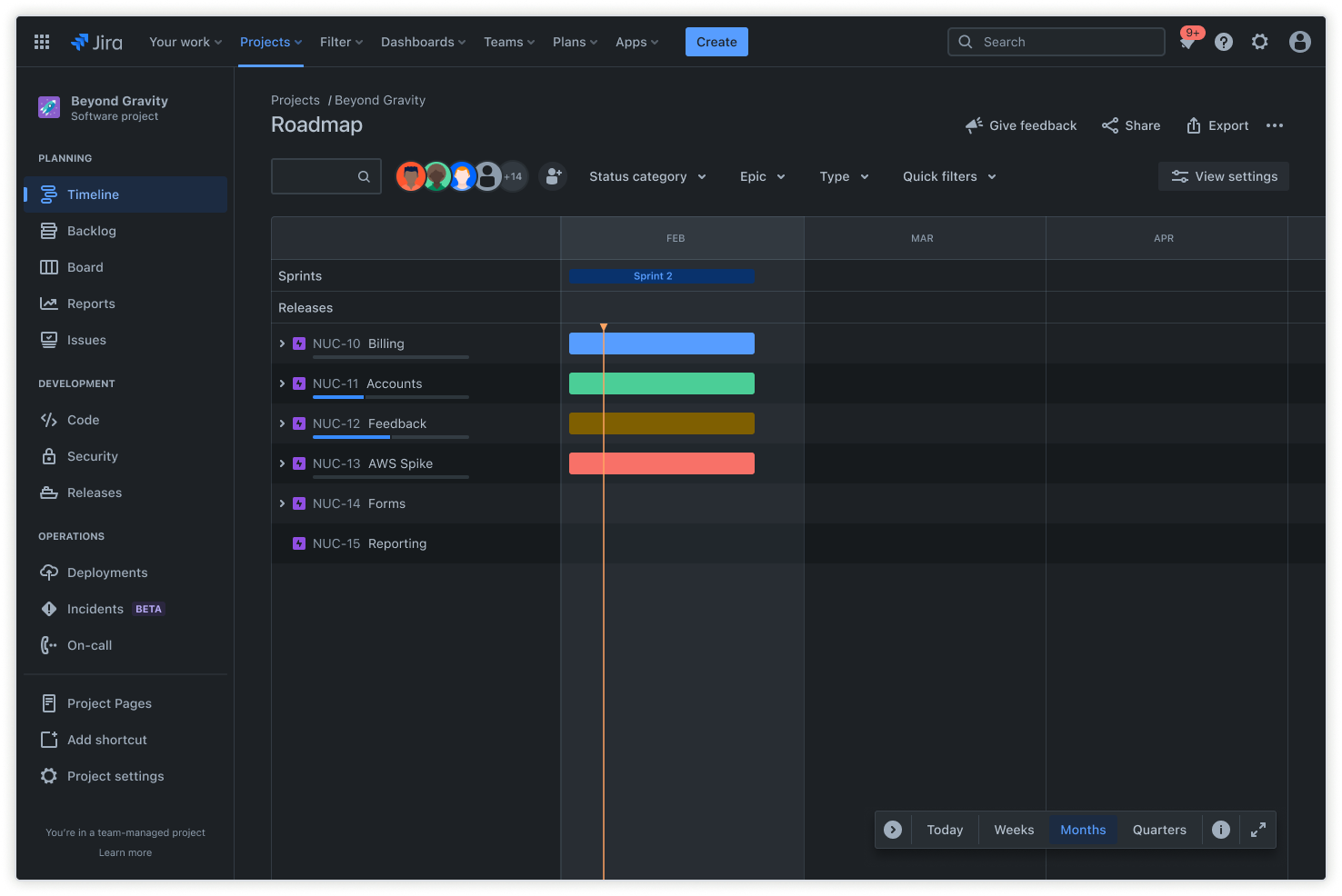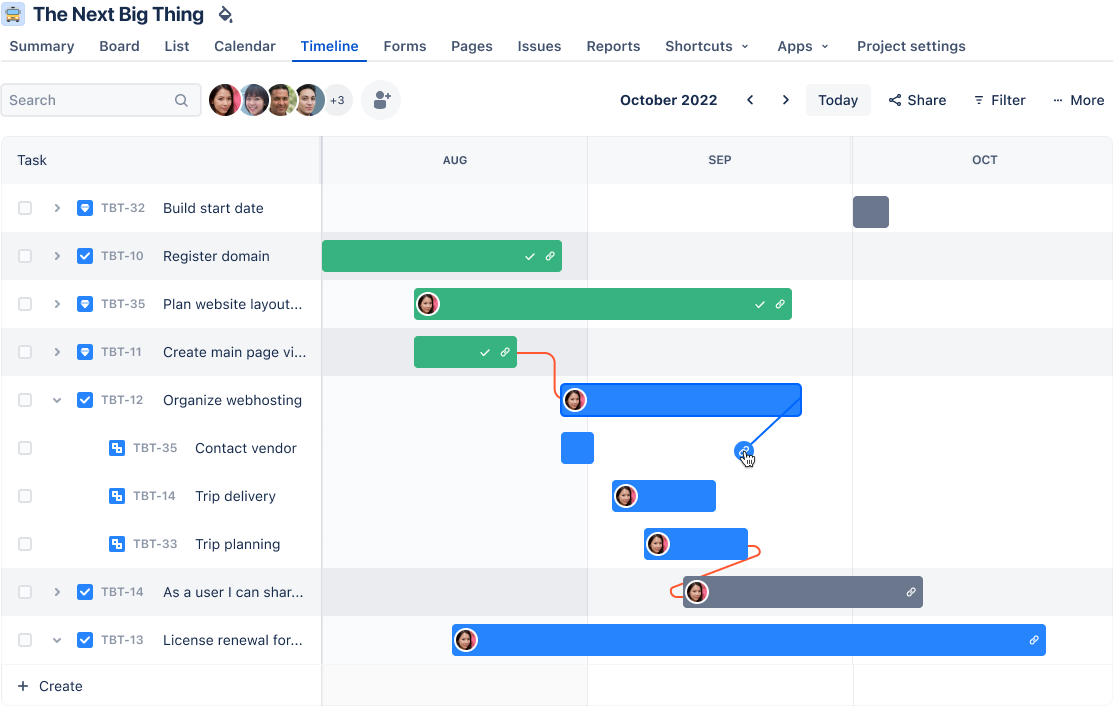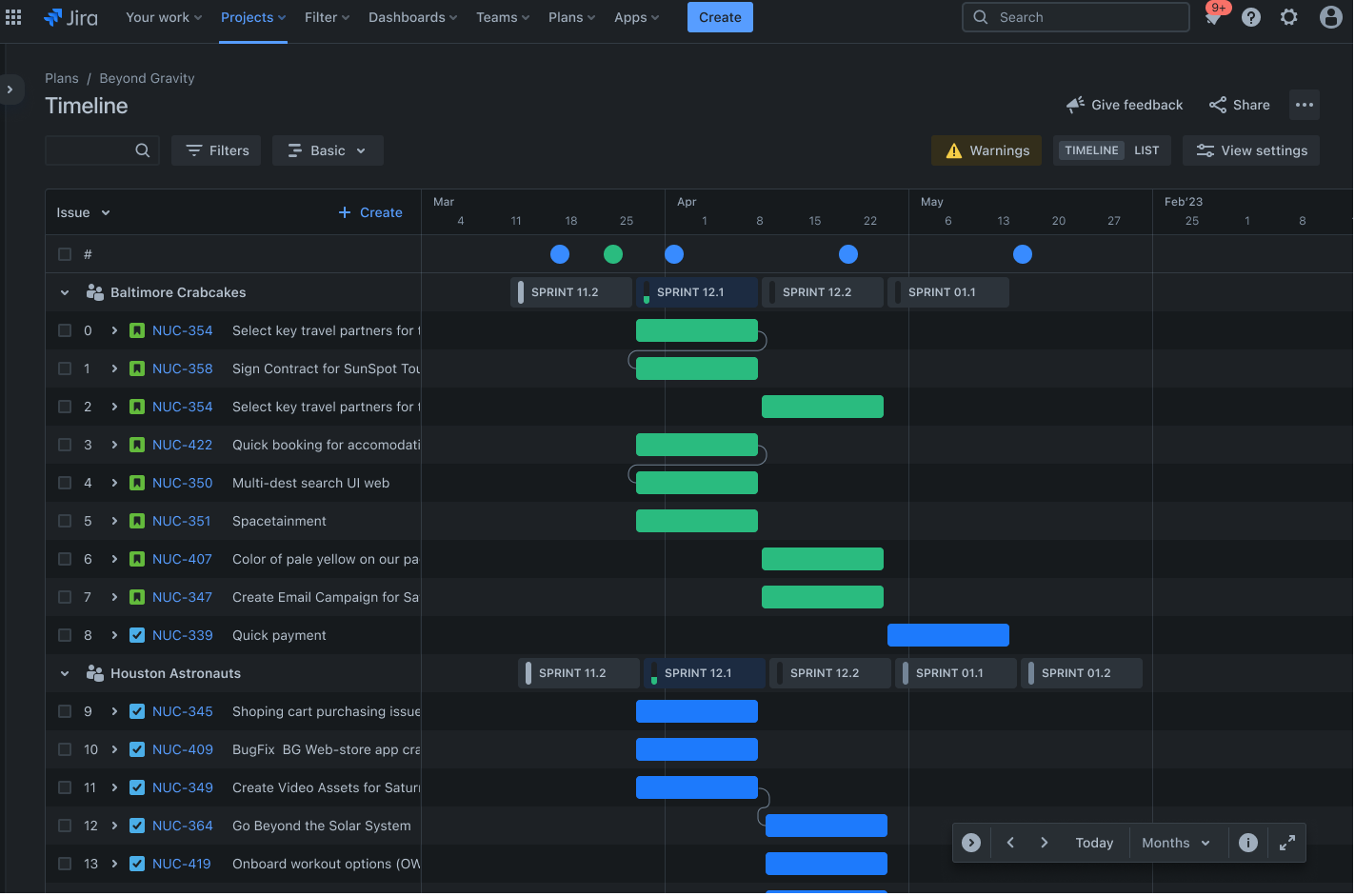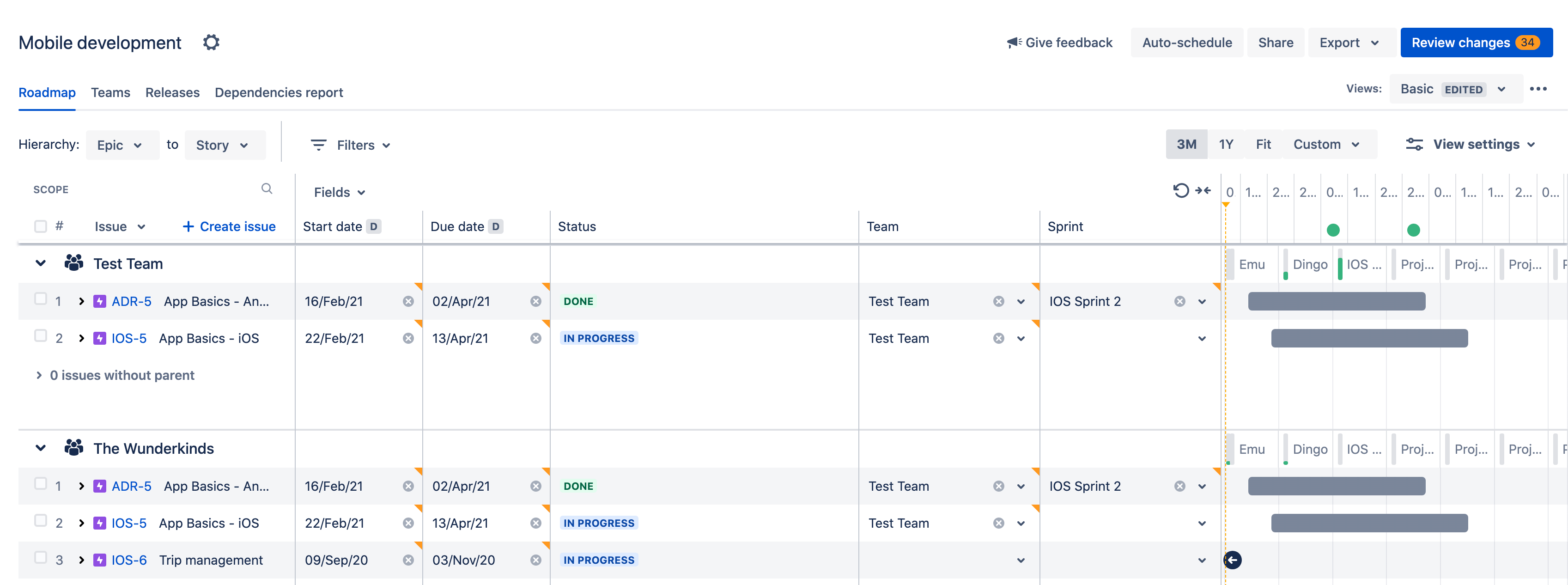Summary: A Gantt chart is a visual timeline for tracking tasks and milestones throughout a project's lifecycle. It offers a high-level overview of project schedules, making it easier to manage complex plans involving multiple teams and shifting deadlines. By providing clear visibility, Gantt charts empower project managers and teams to stay organized and focused on achieving their goals together.
Whether you're managing sprints or long-term projects, this comprehensive guide explores what Gantt charts are, their practical applications, and the many benefits they offer.
Что такое диаграмма Ганта?
A Gantt chart is an agile project management tool used to plan and track the progress of various tasks and activities within a project. Serving as a visual timeline, it displays the list of tasks, their start and end dates, milestones, dependencies between tasks, and assignees.
As a valuable roadmap, a Gantt chart guides teams and organizations in effectively planning and coordinating their work items. By illustrating task interconnections, it fosters seamless collaboration and alignment among project stakeholders, ensuring everyone is on the same page and working towards the same goal.
Преимущества использования диаграмм Ганта
У диаграмм Ганта есть два основных преимущества.
Simplifies complex planning
Gantt charts make it easier to create complex plans, particularly those involving multiple teams and shifting deadlines. They also help teams schedule tasks around deadlines and allocate resources efficiently.
Enhances task scheduling and resource allocation
Project planners rely on Gantt charts for a high-level overview, showing key details like task start and end dates, milestones, and dependencies. Modern Gantt chart programs like Jira Timelines and Jira's Advanced Planning synthesize information and illustrate how choices impact deadlines.
Gantt chart components
Gantt charts typically include two sections; the left side outlines a list of tasks, while the right side shows a project timeline with schedule bars that visualize work. Let's take a closer look at the primary components to look for in a Gantt chart.
Список заданий

A task list is a comprehensive list of all tasks required to complete the project. In Jira, tasks can be created and managed using the issue tracker, which allows you to assign tasks to team members, set priorities, and track progress. This ensures that every team member knows their responsibilities and deadlines, promoting accountability and efficiency. For example, a software development team uses the task list to assign coding, testing, and deployment tasks to different developers, ensuring a smooth workflow.
График

The timeline is a visual representation of the project schedule, showing start and end dates at the top of the chart. Jira's Timeline feature provides a clear view of your project schedule, helping you visualize the sequence of tasks and their durations. Timelines help identify potential bottlenecks and allow for proactive adjustments to keep the project on track. For example, a marketing team uses the timeline to plan a product launch, ensuring all promotional activities are aligned and executed on time.
Зависимости

Links between tasks dictate the order of operations and show how tasks are related. Jira's Advanced Roadmaps allows you to set dependencies between tasks, ensuring that tasks are completed in the correct order and automatically adjusting schedules when changes occur. This prevents delays by ensuring that prerequisite tasks are completed before dependent tasks begin. In a construction project, for example, dependencies ensure that foundation work is completed before building the structure.
КОНТРОЛЬНЫЕ ТОЧКИ

Project milestones on Gantt charts are markers on the project timeline indicating major progress or completion of project phases. In Jira, you can mark key milestones using milestone markers, which help keep your team focused on critical deadlines and achievements. Milestones provide motivation and a sense of accomplishment, helping teams stay focused on long-term goals. A product development team sets a milestone for completing the prototype phase, signaling readiness for user testing.
Для чего используют диаграммы Ганта?
Руководители проектов используют диаграммы Ганта по трем основным причинам.
Создание комплексного проекта и управление им
Диаграммы Ганта позволяют наглядно представить составные части проекта и разбить его на задачи меньшего размера для удобства управления. Получившиеся задачи размещаются на хронологии диаграммы Ганта вместе с зависимостями между ними, исполнителями и контрольными точками.
Отслеживание организационной работы и зависимостей между заданиями
Используйте диаграммы Ганта для отслеживания организационной работы на проекте. Благодаря зависимостям приступить к выполнению новой задачи можно только после завершения предыдущей. Отложенные задачи приводят к автоматическому переносу сроков. Это может оказаться особенно полезным при планировании работы с несколькими командами.
Отслеживание выполнения проекта
По мере того как команды регистрируют в плане время на задачи, можно отслеживать состояние проектов и вносить необходимые коррективы. Диаграмма Ганта может включать даты выпуска, контрольные точки или другие важные показатели для отслеживания прогресса проекта.
Как создать диаграмму Ганта
Давайте посмотрим, как создать наглядную и практичную диаграмму Ганта с учетом ее преимуществ. Рассмотрим основные шаги, начиная с определения объема работ по проекту и заканчивая отслеживанием прогресса, чтобы вы могли создать диаграмму, которая станет ценным инструментом для успешного выполнения проекта.
Step 1: Define the project scope
Первый шаг к созданию диаграммы Ганта — определение объема работ по проекту. Для начала определите основные цели проекта. Четко сформулированные цели послужат ориентиром для проекта, чтобы все задачи согласовывались с ними на протяжении всего жизненного цикла проекта.
Определившись с целями, наметьте основные результаты. Это должны быть конкретные активы, которые необходимо получить в ходе проекта.
Step 2: List all tasks and subtasks
Затем перечислите все задачи, необходимые для получения определенного результата. Разбейте большие задачи на более мелкие, чтобы наглядно показать, что нужно сделать вашей команде. Определите ответственного участника команды и необходимые ресурсы для каждой подзадачи.
Step 3: Estimate task duration
Определите, сколько времени потребуется для выполнения каждой задачи. Будьте реалистичны и учитывайте возможные задержки. Чтобы учесть непредвиденные отсрочки и обеспечить выполнение проекта в срок, заложите в расписание запас времени.
Step 4: Determine task dependencies
Установите последовательность задач. Некоторые задачи можно начать только после завершения других. Для определения взаимосвязей между ними используйте такие типы зависимостей, как «закончить, чтобы начать» или «начать, чтобы начать».
Step 5: Choose a Gantt chart tool
При выборе инструмента для создания диаграммы Ганта оцените несколько факторов, чтобы убедиться, что он соответствует потребностям вашего проекта.
Jira is an excellent option for creating Gantt charts, particularly for software development teams. Tools such as Timelines and Plans help you create advanced roadmaps. These features support detailed task management, dependency tracking, and resource allocation. You can even use a Gantt chart template to streamline the process.
Step 6: Input data
Как только вы получите всю информацию, внесите данные в выбранный инструмент. Добавьте все задачи и сроки их выполнения в диаграмму Ганта. Установите зависимости между задачами, чтобы обеспечить четкую последовательность. Добавьте контрольные точки для обозначения важных моментов в хронологии проекта.
Рекомендации по созданию эффективных диаграмм Ганта
Создание эффективной диаграммы Ганта подразумевает не только ввод данных. Вот несколько полезных рекомендаций.
- Сохраняйте простоту и ясность. Старайтесь не загромождать диаграмму Ганта лишней информацией. Разумно используйте цвета и метки и добавляйте только самые важные задачи и зависимости.
- Используйте цветовую маркировку. Цветовая маркировка помогает представить различные типы задач или этапы работы более наглядно. Это улучшает представление хронологии и упрощает отслеживание прогресса.
- Четко доносите информацию. Чтобы облегчить понимание диаграммы Ганта всеми участниками команды, четко описывайте задачи и отмечайте контрольные точки и типы зависимостей. Это поможет избежать путаницы и ошибок.
- Делитесь информацией с участниками команды и заинтересованными сторонами. Для согласования действий в команде поделитесь диаграммой Ганта со всеми заинтересованными сторонами. Держите всех участников в курсе любых изменений и дополнений к диаграмме Ганта.
- Регулярно обновляйте диаграмму. Диаграмма Ганта должна представлять собой актуальный документ, который регулярно обновляется на протяжении всего проекта. Вносите соответствующие изменения, чтобы график содержал точную информацию о каждой выполненной или отложенной задаче.
-
Работайте с обратной связью. Регулярно запрашивайте обратную связь у команды и включайте ее в диаграмму Ганта, чтобы повысить точность и эффективность.
How different stakeholders utilize Gantt charts
Gantt charts are versatile tools that cater to the diverse needs of various stakeholders within a project team. Here's how different roles utilize Gantt charts, the components they focus on, the questions they aim to answer, and the common challenges they face:
Руководители проектов
Project managers use Gantt charts to oversee the entire project timeline, manage resources, and ensure deadlines are met.
Key questions: "Are we on track to meet our deadlines?" "What resources are needed at each phase?" "How do task dependencies affect the project timeline?"
Common challenges: As a project manager, juggling complex dependencies and resource allocation can be tricky. Jira's Advanced Roadmaps feature helps by automatically adjusting schedules when dependencies change and providing a clear view of resource allocation.
Участники команды
Team members focus on their specific tasks and dependencies to understand their role in the larger project. They interact most with the task list and timeline components to track their responsibilities and deadlines.
Key questions: "What tasks am I responsible for?" "What are the deadlines for my tasks?" "How do my tasks fit into the overall project?"
Common challenges: Managing tasks and tracking changes and dependencies can be constantly shifting. Jira's real-time collaboration and issue tracker features ensure team members are always updated on task changes or dependencies shifts.
Заинтересованные стороны
Stakeholders view high-level progress and milestones to stay informed about the project's status. They focus on milestones and visual aids to grasp the project's progress quickly.
Key questions: "What is the current status of the project?" "Have we reached key milestones?" "Are there any major risks or delays?"
Common challenges: When trying to understand complex project details, stakeholders can feel easily overwhelmed by information. Jira's customizable views and milestone markers provide stakeholders with a clear, high-level overview of the project, ensuring they are informed without being overwhelmed.
By leveraging Jira's robust features, each stakeholder can effectively use Gantt charts to meet their specific needs, ensuring a cohesive and well-managed project.
Key features of Gantt chart software
Gantt chart software, like Jira, offers advanced features to enhance project management efficiency and effectiveness. Here's why these features are essential:
Automatic scheduling
This feature automatically adjusts timelines when task dependencies change, ensuring your project plan remains accurate and up-to-date. It saves time and reduces the risk of human error, allowing project managers to focus on strategic planning rather than manual updates.
Управление ресурсами
Efficient resource allocation is crucial for project success. Effective resource management features help distribute tasks and resources across teams, optimizing workload and preventing burnout. This ensures that all team members are utilized effectively, contributing to a balanced and productive work environment.
Совместная работа в режиме реального времени
With real-time collaboration, team members can update progress and communicate changes instantly. This feature fosters transparency and keeps everyone aligned, reducing miscommunication and enhancing team cohesion. It is particularly beneficial for remote teams or projects with tight deadlines.
Customizable views
Different projects require different perspectives. Jira offers customizable views, such as daily, weekly, or monthly timelines, to suit various planning needs. This flexibility allows project managers to tailor their Gantt charts to specific project requirements, improving clarity and focus.
Integrations and compatibility
Gantt chart tools are most effective when they integrate seamlessly with other project management software and platforms. Jira excels in this area by offering robust integrations with tools like Trello and BigPicture. These integrations enable smooth project management across different systems, enhancing collaboration and efficiency.
By incorporating these features and integrations, Jira is a comprehensive solution for modern project management needs.
Принципы использования диаграмм Ганта в Jira
В Jira включены две функции создания дорожных карт, каждая со своей направленностью. Хронологии Jira предназначены для отслеживания работы, порученной одной команде, а планы — для планирования проектов более крупного масштаба, например межорганизационных.
Диаграммы для конкретного проекта — хронологии Jira
На приведенном ниже снимке экрана хронологии показана диаграмма Ганта для конкретного проекта, которая обычно используется на уровне команды или внутри одной группы. Диаграмма отражает движение команды к намеченным целям, а раскрывающаяся структура распределения задач дает руководителям проектов общее представление о самых важных историях проекта. В Jira доступен бесплатный шаблон управления проектами, включающий диаграммы Ганта.

Организационная диаграмма высокого уровня — планы
Планы в Jira предназначены для быстрого и легкого планирования, чтобы команды могли лучше управлять зависимостями и отслеживать прогресс в рамках общей картины и в режиме реального времени. Такие дорожные карты на уровне проекта или команды полезны для планирования крупных задач в рамках команды.
Планирование, отслеживание работы и управление ею в нескольких командах или даже во всей организации с помощью планов расширяет возможности команд при любом масштабе.

Программы, разработанные с учетом межкомандных рабочих процессов, предлагают продвинутые инструменты, такие как управление производительностью и функции автоматического планирования для создания более сложных планов. Кроме того, они имеют различные настройки представления, позволяющие персонализировать диаграмму Ганта и выделить определенные аспекты плана при демонстрации.
Elevate your project management with Jira's Gantt charts
Transform your project management approach with the power of Gantt charts in Jira. These visual timelines are not just about tracking tasks—they're about achieving your project goals precisely and clearly. By leveraging Jira's robust features, you can create Gantt charts that are efficient and pivotal in steering your projects toward success.
Jira seamlessly integrates with various Gantt chart tools, providing a holistic project tracking and management solution. This integration ensures that your project timelines are always up-to-date, allowing real-time adjustments and insights.
Harness the full potential of Jira's capabilities to manage your Gantt charts effectively. With real-time updates, customizable dashboards, and advanced reporting, Jira empowers you to keep your projects on track and your team aligned.
Are you ready to revolutionize your project management strategy?
Связанные ресурсы
- Ресурсы по управлению проектами
- Ресурсы по планированию проекта
- Ресурсы по запуску продукта
- Стратегии по управлению проектами для выхода на рынок
- Ресурсы по управлению ресурсами
- Ресурсы по отслеживанию заданий
- Ресурсы по управлению маркетинговыми проектами
- Ресурсы по управлению программами
- Ресурсы для руководителей проектов
- Управление проектами по разработке ПО
